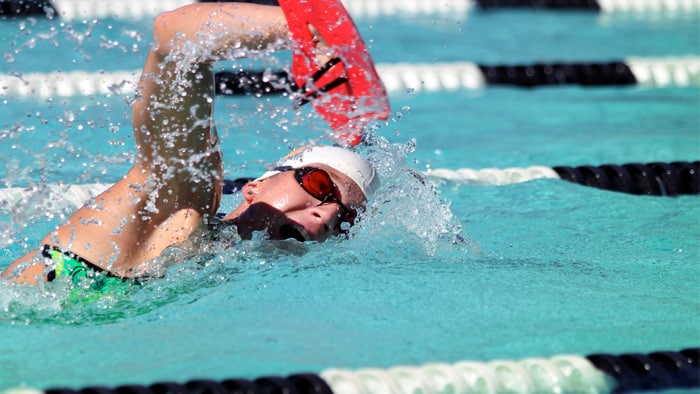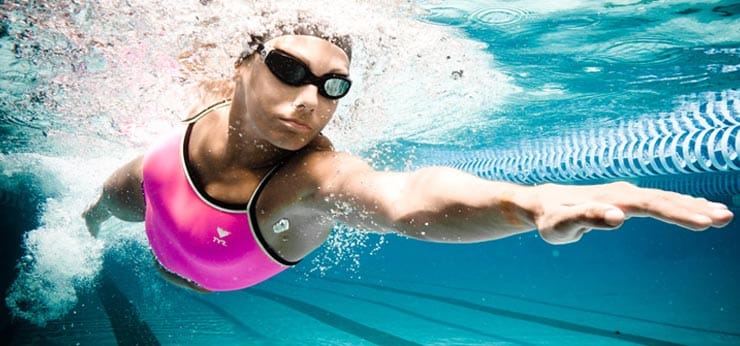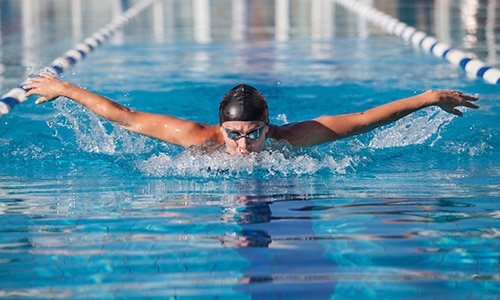Building your own swim sessions
Building your own swim session is easy.
The key to making a good workout is to have an intention, a singular focus for the session itself be it speed, endurance, form, force/power, or pacing.
Endurance will have longer distances at more controlled efforts while sprint and speed focus will be shorter and faster. Form focus will have more drills, and power/force will include paddles or sets with increased drag. When considering rest, think about this intention. If you are focusing on endurance, your rest should be short while your sprint sets should have more so that you can hit each one with quality.
If you have multiple sets, you can pick several focuses but each set should revolve around just one. For example, a form set of 10×50 with several drills followed by an endurance set of 5x500s at zone two, followed by a sprint set of 10×25 at all out pace with a kick set of 4×100 in which each one is negative split.

Below you will find a list of terms that you can use to build your own training sessions
Zone 2: I stole this term from cycling and running, both of which define it as about 65-70% of your max heart rate. Zone 2 is a pace that you feel you can hold all day, that you could hold a conversation as if you were biking or running. It is not EASY like a warmup but rather a sustainable and relaxed pace – maybe 5 or 6 out of 10 on a rate of perceived exertion (RPE) scale. Some like to call this Ironman swim pace. You should be able to bilateral breath (if you only do this at a steady pace). It should be included with an endurance focus.
Tempo/threshold/CSS pace: Tempo is faster than zone 2 but is not an all-out sprint. You should be breathing harder maybe even breathing every other stroke. Consider it just above mile pace. This is “moderate” pace.
Race pace: the pace you want to hold in your goal race. This can be further specified to Sprint, Olympic, half ironman/70.3, and IM race pace.
TT pace: While it means “time trial” or all-out effort over a set distance, the actual time and effort are dependent upon you and what your goals are. TT could refer to your pace for a 100, 500, 1000, 1650, 4000k, or 10k effort. However, nearly always TT means a hard effort above race pace.
Easy pace: Just like it sounds–easy like a warmup or cool down.
12 kicks to 3 pulls or 6 kicks to 3 pulls: One of my favourite drills where you take 12 or 6 kicks to one side with your belly button pointing to the wall, one arm extended, head down, chin tucked and looking down at the bottom of the pool. Then take 3 smooth strokes and take 12 or 6 kicks to the other side after which you take 3 strokes, and repeat. Focus here is on good body alignment and rotating your body as one.

Fist drill: swim normally with clenched fists or you can hold tennis balls so that you do not cheat – all about trying to use your forearms to grip the water.
Catch-up: No this does not mean what you put on burgers. It is a slowed down swim stroke drill where you are focusing on one arm at a time. Take one stroke focusing on a high elbow catch, quick pull, then shallow entry. Pause once one stroke is complete and then do the same on the other side.
Water polo/head up/Tarzan drill: Another favourite, this one you swim Tarzan style with your head completely out of the water. Be careful where you put your hand and try to keep your head steady without twisting. Good for watching your entry/hold on the water, but also as sighting practice.
Build: building in intensity so that you get faster each 25 or 50 and finish in an all-out sprint.

N/S: Negative split means your second half of the distance is faster than your first
Sculling: Perfect in a warm-up or to remind you of form under the water – sculling is small lateral movements at different parts of the stroke (eg entry, midpoint and exit). You could do half-length scull and then break into full stroke – hopefully feeling the power through the worked upon section of the pull!
DPS: This means distance per stroke. It’s not something I put in regularly, but it’s all about focussing on maximum distance travelled per stroke done – without gliding and losing speed.
Individual Medley (IM): Swimming all four strokes – butterfly, backstroke, breaststroke & freestyle, in that order. Many people drop the butterfly or replace it with extra freestyle. Great for aerobic swims, or breaking up a warm up and thinking about how you move forward.

Kick: The triathlete’s favourite! A couple of lengths here and there every session can stretch out your hip flexors and improve your efficiency so you don’t wear yourself out in a race. You can do side kick, streamlined kick (front or back), vertical kick – or my favourite, arms by side and rotating.
Pull: Swimming with paddles and/or a pull buoy usually with feet bound with a band.
Band: Feet wrapped and tied so that they do not move.
Hypoxic: Means holding your breath for a certain number of strokes like 5, 7 or 9 strokes – or even doing full lengths no air.
25 or 50 or 100 or 250 etc. refers to the distances that you swim. Typically a length is 25 meters. It can be 50 meters if you are in a long course pool.
Odds and evens: Refers to the odd or even reps so if you are doing 100×100 with odds as sprints and evens as easy, reps 1,3,5… are sprint and 2,4,6,…are easy.
Poolside push-ups: Pushing yourself up out of the water as if you are getting out of the pool and then coming back down. This is a great tricep and lat workout.
Now different coaches will use the same term to refer to something completely different, so be careful translating these term in masters’ swim practices or magazine articles.
If you have any questions or comments, please feel free to get in touch; either by email, facebook or leave a comment on here! Remember, you can always get your swimming reviewed in the endless pool with our video swim analysis packages.
See what’s up next week for our #SwimTechTues tip!

